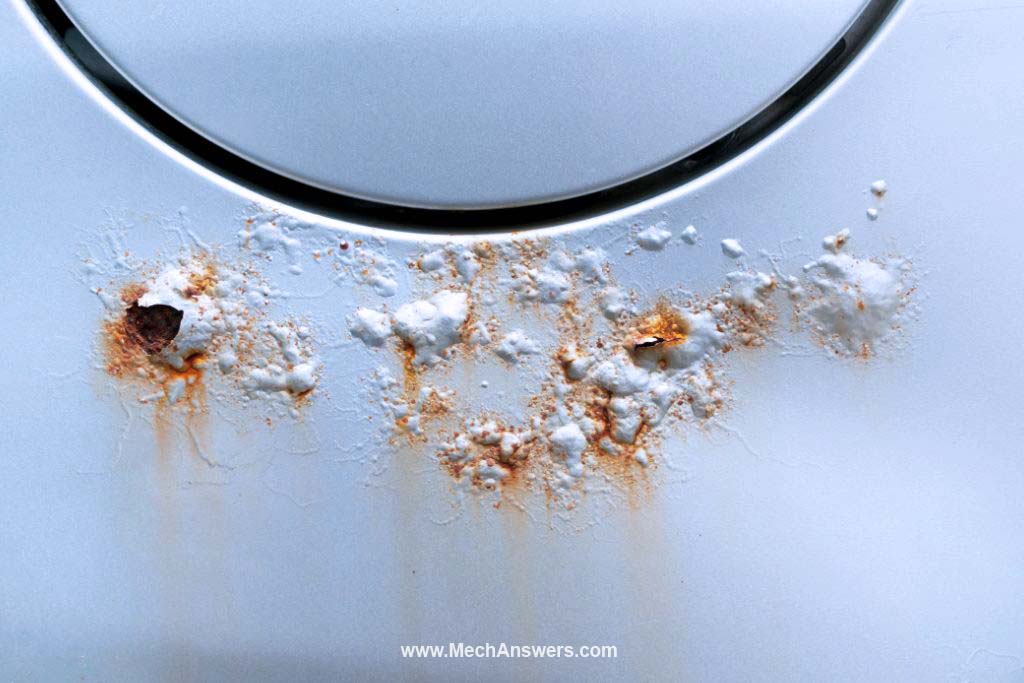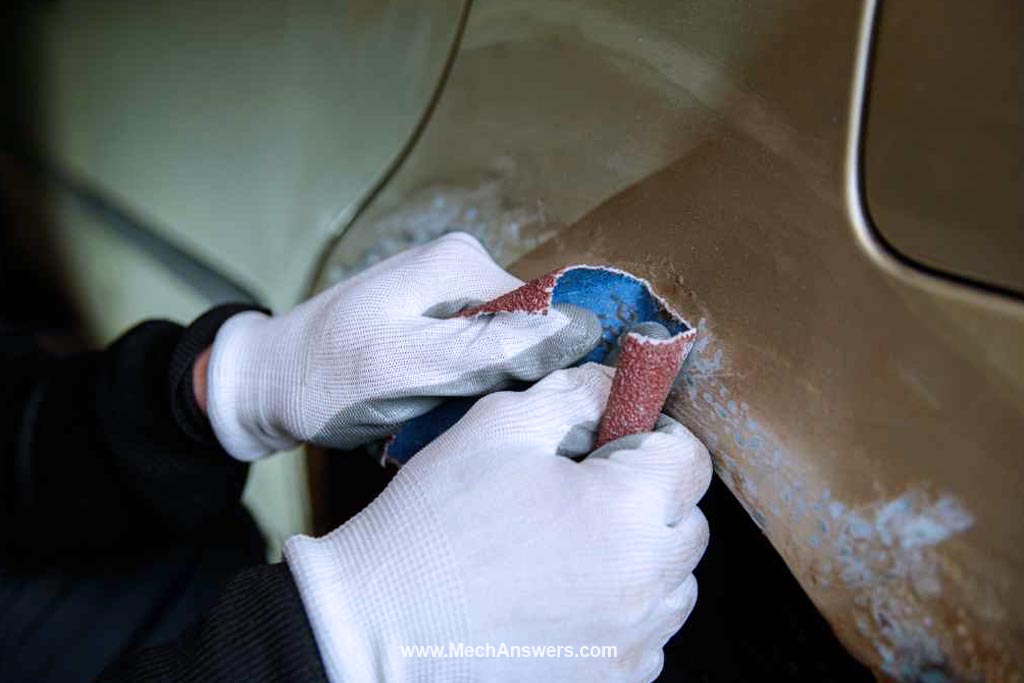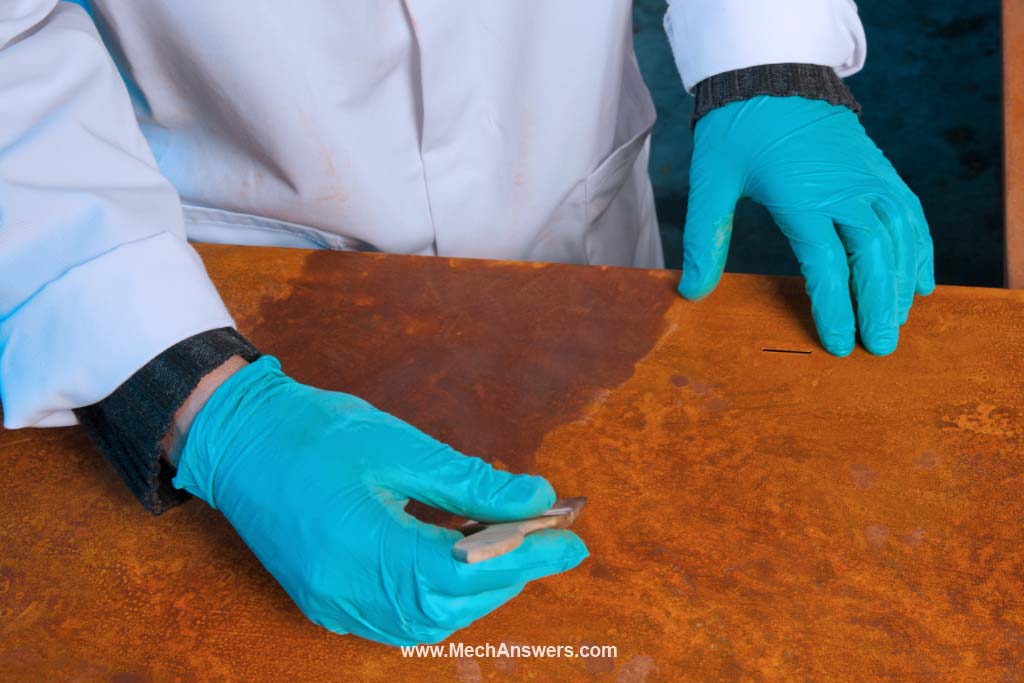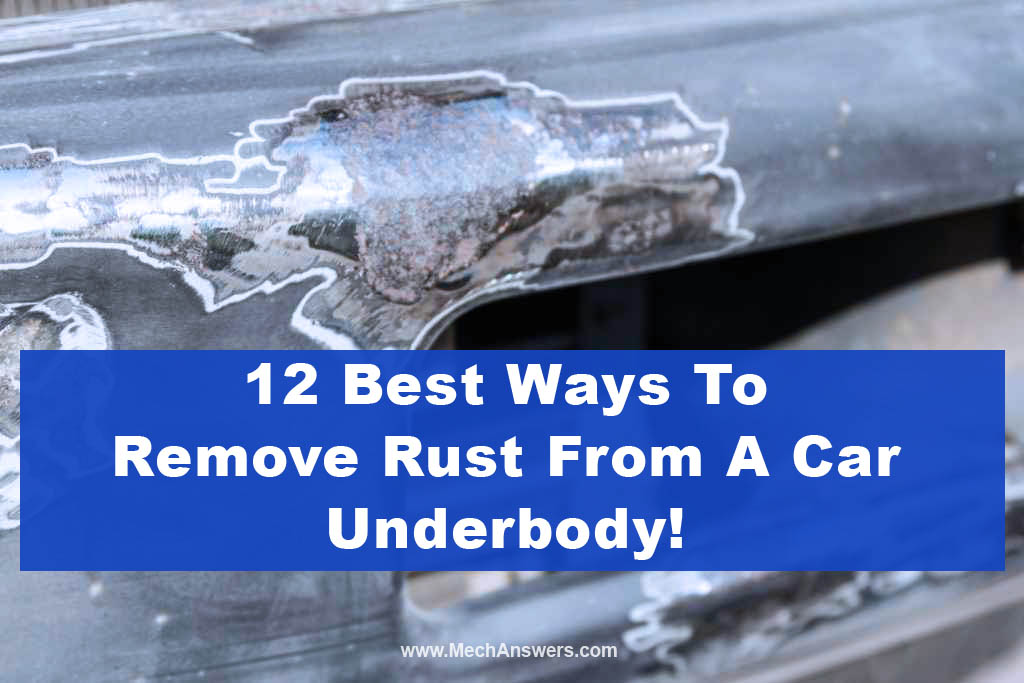In your quest for car maintenance tips, you might have found yourself asking, “What’s the best way to remove rust from a car underbody?” You’re not alone in this; many car owners are in a similar predicament. If this sounds like you, your search ends here.
So, what can you expect from the “Best Way To Remove Rust From A Car Underbody”? You can anticipate a detailed analysis of 12 proven methods to combat the undesirable rust, tailored to suit a variety of situations and preferences, ensuring you find a solution that’s right for you.
This article is a must-read for anyone keen on prolonging the lifespan of their vehicle while maintaining its aesthetic appeal. No one enjoys the sight of a rusty car, and with this guide, you won’t have to.
Table of Contents
Recognizing the Signs of Rust
Visible rust spots
One of the most apparent signs of rust is the presence of visible rust spots on the car’s underbody. These spots typically appear as reddish-brown patches or stains on the metal surfaces.
They can vary in size and severity, from small specks to larger, more advanced rust areas. Regularly inspecting your car’s underbody for visible rust spots can help you detect and address the issue before it becomes a more significant problem.
Bubbling or flaking paint
Another sign of rust formation is bubbling or flaking paint on your car’s exterior or underbody. As rust forms underneath the paint, it causes the paint layer to lift and separate from the metal surface, leading to visible bubbles or flakes.
If left untreated, the rust will continue to spread, eventually causing the paint to chip off and exposing the metal to further corrosion.
Weakened structural components
Rust can weaken the structural components of your car, compromising its safety and performance.
If you notice any areas of your car’s underbody that appear bent, warped, or thin, this could indicate that rust has weakened the metal.
It’s crucial to address this issue immediately to prevent further damage and ensure your vehicle remains safe to drive.
Unusual noises while driving
As rust affects the structural integrity of your car’s underbody, it may cause unusual noises while driving.
These noises can include creaking, rattling, or clunking sounds, particularly when driving over bumps or during turns.
If you notice any unusual noises, it’s essential to investigate the cause and address any rust issues to prevent further damage to your vehicle.

Best Way To Remove Rust From Car A Underbody – Mechanical Methods
1. Wire Brush
Advantages:
- Inexpensive and readily available
- Easy to use, even for beginners
- Effective for removing light surface rust
Disadvantages:
- Time-consuming for large rusted areas
- May not be effective on heavily rusted surfaces
- Can scratch or damage the metal if used too aggressively
How to use:
- Choose a wire brush appropriate for the size and severity of the rusted area
- Apply firm pressure and scrub the rusted surface in a back-and-forth motion
- Continue scrubbing until the rust is removed, revealing the bare metal d. Wipe away any rust debris with a clean cloth
2. Sandpaper
Advantages:
- Effective for removing light to moderate rust
- Provides a smooth finish on the metal surface
- Available in various grits for different levels of rust severity
Disadvantages:
- Time-consuming, especially for large rusted areas
- Can be physically demanding
- May require multiple grits for optimal results
How to use:
- Select sandpaper with an appropriate grit for the rust severity
- Fold or cut the sandpaper to a manageable size
- Sand the rusted area using a back-and-forth or circular motion, applying even pressure
- Switch to finer grit sandpaper if necessary to smooth the surface e. Wipe away any rust debris with a clean cloth
3. Sandblasting
Advantages:
- Highly effective for removing heavy rust and paint
- Can quickly clean large rusted areas
- Provides a clean, uniform surface for repainting
Disadvantages:
- Expensive equipment and materials required
- Can be messy and requires a suitable workspace
- May require professional assistance for proper use
How to use:
- Rent or purchase a sandblasting kit and appropriate abrasive material
- Set up a suitable workspace, ensuring proper ventilation and protection from the sandblasting debris
- Follow the manufacturer’s instructions for assembling and operating the sandblaster
- Direct the sandblasting nozzle at the rusted area, maintaining a consistent distance and angle
- Continue sandblasting until the rust is removed and the metal surface is clean
4. Angle Grinder
Advantages:
- Efficient for removing heavy rust and paint
- Can quickly cover large rusted areas
- Versatile, with multiple attachments available for different tasks
Disadvantages:
- Requires experience and skill to use safely and effectively
- Can cause damage to the metal surface if not used correctly
- Generates sparks and debris, requiring appropriate safety gear and workspace
How to use:
- Choose an angle grinder with the appropriate power and size for your project
- Attach a wire wheel or flap disc suitable for rust removal
- Put on safety gear, including eye protection, gloves, and a mask
- Turn on the angle grinder and gently apply it to the rusted area, using smooth and even strokes
- Avoid applying excessive pressure or staying in one spot for too long to prevent damage to the metal surface
- Wipe away any rust debris with a clean cloth
5. Needle Scaler
Advantages:
- Efficient for removing heavy rust and paint
- Can access hard-to-reach areas, such as tight corners and crevices
- The pneumatic operation provides consistent power and performance
Disadvantages:
- Requires an air compressor for operation
- Can be noisy and requires hearing protection
- Generates debris, requiring appropriate safety gear and workspace
How to use:
- Choose a needle scaler with the appropriate power and size for your project
- Connect the needle scaler to an air compressor, following the manufacturer’s instructions
- Put on safety gear, including eye protection, gloves, and hearing protection
- Position the needle scaler’s needles against the rusted surface and activate the scaler
- Move the scaler across the rusted area, allowing the needles to chip away at the rust and paint
- Continue until the rust is removed, revealing the bare metal

Best Way To Remove Rust From Car A Underbody – Chemical Methods
6. Rust Converter
Advantages:
- Converts rust into a stable, inert substance
- Provides a protective coating to prevent further rusting
- Easy to apply, even for beginners
Disadvantages:
- May not be suitable for heavily rusted surfaces
- Requires time for the chemical reaction to occur
- May need an additional topcoat for optimal protection
How to use:
- Clean the rusted surface to remove loose rust, dirt, and debris
- Apply the rust converter to the rusted area with a brush or roller, following the manufacturer’s instructions
- Allow the converter to dry, typically between 24 to 48 hours
- Apply additional topcoats, such as paint or primer, if necessary
7. Rust Remover
Advantages:
- Effectively dissolves rust from metal surfaces
- Available in liquid, gel, or spray forms for different applications
- Can be used on various metals, including steel, iron, and chrome
Disadvantages:
- May require multiple applications for heavy rust
- Can be harmful to skin and eyes if not handled properly
- Requires proper disposal of the used rust remover
How to use:
- Choose a rust remover suitable for your project and the type of metal
- Follow the manufacturer’s instructions for application, ensuring proper safety measures
- Allow the rust remover to work on the rusted surface for the recommended time
- Rinse or wipe off the rust remover and rust residue with water or a cloth
- Dry the metal surface thoroughly to prevent further rusting
8. Phosphoric Acid
Advantages:
- Effectively removes rust and creates a protective layer on the metal surface
- Can be used as a rust converter and a rust remover
- Available in various concentrations for different rust severity levels
Disadvantages:
- Can be hazardous if not handled properly
- May damage other materials, such as plastics or rubber
- Requires proper ventilation and safety gear during use
How to use:
- Choose a phosphoric acid product suitable for your project
- Apply the phosphoric acid to the rusted surface with a brush or spray, following the manufacturer’s instructions
- Allow the phosphoric acid to react with the rust, typically between 15 minutes to several hours, depending on the severity
- Wipe or rinse off the phosphoric acid and rust residue with water or a cloth
- Dry the metal surface thoroughly to prevent further rusting
9. Vinegar and Baking Soda
Advantages:
- Inexpensive and readily available ingredients
- Non-toxic and environmentally friendly
- Effective for light to moderate rust removal
Disadvantages:
- May not be suitable for heavily rusted surfaces
- Requires more time to work compared to commercial rust removers
- Can leave an odor on the treated surface
How to use:
- Mix equal parts white vinegar and baking soda to form a paste
- Apply the paste to the rusted area, ensuring complete coverage
- Allow the paste to sit on the rusted surface for several hours or overnight
- Scrub the rusted area with a brush or cloth to remove

Best Way To Remove Rust From Car A Underbody – Electrochemical Methods
10. Electrolysis
Advantages:
- Highly effective for removing heavy rust, even in hard-to-reach areas
- The non-destructive method that preserves the original metal surface
- Environmentally friendly, using only water and a small amount of electricity
Disadvantages:
- Requires basic knowledge of electricity and safety precautions
- Setup can be time-consuming and requires specific materials
- May not be suitable for large rusted areas or complex car underbody components
How to set up and use:
- Gather materials, including a non-conductive container (such as a plastic tub), a DC power supply (e.g., battery charger), a sacrificial anode (a piece of steel or iron), and washing soda (sodium carbonate)
- Fill the container with enough water to cover the rusted area, and dissolve a small amount of washing soda in the water (approximately 1 tablespoon per gallon)
- Suspend the sacrificial anode and the rusted part in the water, ensuring they do not touch each other or the sides of the container
- Attach the positive lead from the power supply to the sacrificial anode and the negative lead to the rusted part
- Turn on the power supply and let the electrolysis process run for several hours or until the rust is removed
- Turn off the power supply, remove the rusted part from the water, and rinse it thoroughly to remove any rust residue
- Dry the metal surface completely to prevent further rusting
Best Way To Remove Rust From Car A Underbody – Natural Methods
11. Citric Acid
Advantages:
- Readily available and inexpensive
- Non-toxic and environmentally friendly
- Effective for light to moderate rust removal
Disadvantages:
- May not be suitable for heavily rusted surfaces
- Requires more time to work compared to commercial rust removers
- Can leave a residue on the treated surface
How to use:
- Mix the citric acid powder with water to create a solution (follow the manufacturer’s recommended ratio)
- Submerge the rusted part or apply the solution to the rusted area with a brush or spray bottle
- Allow the solution to work on the rust for several hours or overnight
- Scrub the rusted area with a brush or cloth to remove the loosened rust
- Rinse and dry the metal surface thoroughly to prevent further rusting

12. Lemon and Salt
Advantages:
- Inexpensive and commonly available household items
- Non-toxic and environmentally friendly
- Effective for light rust removal
Disadvantages:
- May not be suitable for heavily rusted surfaces
- Requires more time to work compared to commercial rust removers
- Can leave a residue or odor on the treated surface
How to use:
- Cut a lemon in half and sprinkle salt on the cut surface
- Rub the lemon half with salt on the rusted area, applying light pressure
- Allow the lemon and salt mixture to sit on the rusted surface for several hours or overnight
- Scrub the rusted area with a brush or cloth to remove the loosened rust
- Rinse and dry the metal surface thoroughly to prevent further rusting
How to Clean up Frame Rust on a Budget >> Check out the video below:
Related Articles:
Read more >> What’s Normal for Rust on the Undercarriage? Need-to-Know!
Read more >> How Long Will a Rusted Frame Last? (Need-To-Know Facts!)
Read more >> 12 Analytical Signs: How To Tell If A Frame Is Too Rusted
Selecting the Right Method for Your Vehicle
Assessing the extent of rust
- Examine the rusted areas to determine the severity of rust
- Differentiate between surface rust, scale rust, and penetrating rust
- Identify if rust has compromised the structural integrity of the vehicle or if it is merely cosmetic
Evaluating your budget and time constraints
- Determine the amount of money and time you can invest in rust removal
- Consider the cost of materials, tools, and potential professional assistance
- Choose a rust removal method that aligns with your budget and time availability
Considering environmental factors
- Assess the impact of your chosen rust removal method on the environment
- Opt for eco-friendly methods, such as natural or non-toxic chemicals, when possible
- Ensure proper disposal of waste materials generated during the rust removal process
Weighing the pros and cons of each method
- Analyze the advantages and disadvantages of each rust removal method
- Consider the effectiveness, ease of use, safety, and potential damage to your vehicle
- Select the method that best suits your specific situation, rust severity, and personal preferences
Rust Prevention Methods
Rust Inhibitor Paint
Advantages:
- Provides a protective barrier against moisture and oxygen
- Can improve the appearance of your vehicle
- Available in various colors and finishes
Disadvantages:
- Requires proper surface preparation for optimal adhesion
- May need regular touch-ups and reapplication over time
How to use:
- Clean and remove any rust or debris from the surface
- Apply a primer, if necessary, to ensure better adhesion
- Apply the rust inhibitor paint according to the manufacturer’s instructions
- Allow the paint to dry completely before using the vehicle
Undercoating
Advantages:
- Provides an additional layer of protection against rust and corrosion
- Can reduce road noise and improve the ride quality
- May increase the resale value of your vehicle
Disadvantages:
- Can be time-consuming and messy to apply
- May require a professional application for optimal results
How to use:
- Clean the underbody of your vehicle thoroughly, removing dirt, debris, and any existing rust
- Apply the undercoating material according to the manufacturer’s instructions, ensuring even coverage
- Allow the undercoating to dry completely before using the vehicle
Regular Maintenance
Importance:
- Keeps your vehicle in optimal condition
- Helps identify and address potential rust issues early
- Extends the life of your vehicle
Steps to take for proper maintenance:
- Wash your vehicle regularly, including the underbody, to remove dirt, salt, and other contaminants
- Inspect your vehicle for signs of rust and address them promptly
- Maintain your vehicle’s paint and protective coatings
Wax and Oil-based treatments
Advantages:
- Creates a moisture-resistant barrier on the surface
- Can be applied to hard-to-reach areas, such as crevices and seams
- Easy to reapply as needed
Disadvantages:
- May not provide as durable protection as paint or undercoating
- Can be messy and may require special equipment for application
How to use:
- Clean the surface of your vehicle thoroughly, removing dirt, debris, and any existing rust
- Apply the wax or oil-based treatment according to the manufacturer’s instructions, ensuring complete coverage
- Allow the treatment to dry, if necessary, before using the vehicle
Conclusion
Keeping your vehicle’s underbody free of rust is essential for maintaining its structural integrity, appearance, and resale value.
With the 12 rust removal methods outlined in this article, you have various options to choose from, depending on the extent of rust, your budget, and your personal preferences.
Remember to consider the pros and cons of each method, and always prioritize safety when undertaking any rust removal process.
Additionally, implementing preventative measures such as using rust inhibitor paint, undercoating, and regular maintenance can help protect your car from rust in the long run. By staying vigilant and proactive, you can preserve your vehicle’s lifespan and enjoy a safe, comfortable driving experience.

